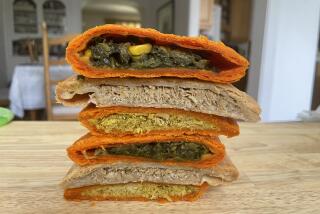Chew on this, trail mix sissies
- Share via
At Patty’s Place, along the Ortega Highway in Cleveland National Forest, a wood stove sits in the corner, massive Betty Boop ceramics crowd a table and ostrich eggshells the size of peewee footballs fill a cardboard box.
Patty Lockhart, a white-haired senior wearing a blouse in the crayon box’s brightest colors, stands behind a glass counter splayed with 13 varieties of treats. There are no price tags.
“I want to tell my customers about the product,” she says with evangelical glee.
A middle-aged couple strolls in, and Patty fires into her sales pitch.
“Have you had jerky before?”
“No,” the man concedes.
Lockhart unleashes a spiel about the Evansville, Ind.-based House of Jerky being the only brand she’ll eat, how she never ate jerky until she opened the store four years ago. The couple leaves with two 4-ounce bags totaling $16. A tattooed motorcycle rider strides in a minute later and also buys two bags.
Jerky doesn’t discriminate.
And it’s everywhere these days. Jerky strips as long and thick as a school ruler -- a half an hour of heavy chewing -- beckon from clear plastic tubs. For the weak in jaw, cardboard rounds bulge with shredded jerky for packing between the cheek and gum.
Jerky stands such as Patty’s dot California’s paved routes to trails and slopes. In 2002, American carnivores dropped $2.1 billion on more than 138.8 million pounds of “shelf stable meat products,” according to the Snack Food Assn. (Note: Pork rinds fall into a separate snack food category.)
In the last five years, annual sales have steadily increased, driven partly by backcountry explorers.
Hikers and campers depend on room-temperature dried-up meat or fish -- even veggies. Jerky is compact, light and withstands wild temperature swings. Unopened, it can last more than a year. And it’s easy to spot spoiled jerky.
“What it does is mold -- just look at it and see the fuzz,” says Ron Hargett of House of Jerky, a nationwide chain of 18 stores.
“It’s a good social food,” says Gwyn Benedict, manager of Adventure 16 in Solana Beach, Calif., and a backpacking instructor. “I often break out a pack [while hiking] and pass it around.” But it’s not a primitive PowerBar.
Although it’s a good protein source, “you usually don’t eat enough to make much of a difference,” she says.
Yet Kevin Harris calls jerky “survival food.” Before he ATVs or snowboards in his downtime as a skateboard distributor, he hits his corner gas station in Ladner, Canada, to stock up. Throughout the day, he gnaws open vacuum-sealed plastic packages and stuffs his cheeks with Cheetos-size meat shards.
In any form, jerky demands an atavistic eating style: mouth open, saliva sloshing, jaw mashing. This rowdy form of consumption is accepted on the frontier and is another part of the draw, harking to the days when explorers traded with Native Americans for jerky. They wind- or smoke-dried their meat.
You can make your own jerky too. Slice any cut of meat, marinate it and dry it in the oven. No oven? Make your own dehydrator according to the instructions in Backwoodsman, a magazine for frontiersmen:
1) Line the inside of a cardboard box with foil. 2) Poke straightened coat hangers through the middle of the box to create a rack. 3) Hang a 60-watt light bulb inside the box. 4) Kill and skin whatever varmint is handy, slice the meat off and hang the strips until dry.
And if your meat doesn’t turn out, visit a place like Patty’s -- because she knows bad jerky.
“It swells as you chew,” Lockhart says, as if describing a bad practical joke. “You chew and chew, and it won’t go away.”
More to Read
Sign up for The Wild
We’ll help you find the best places to hike, bike and run, as well as the perfect silent spots for meditation and yoga.
You may occasionally receive promotional content from the Los Angeles Times.






